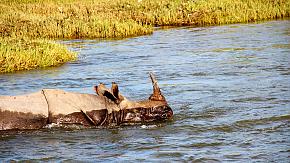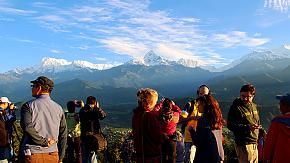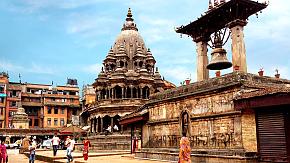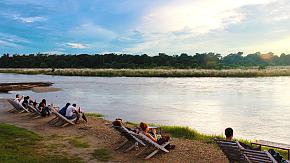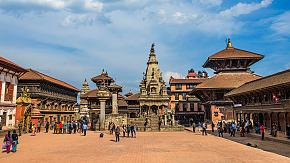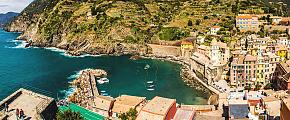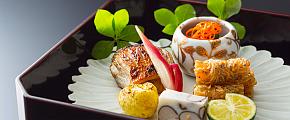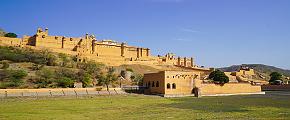A Complete Travel Guide of Kathmandu
Kathmandu is the capital city of Nepal, located at the foot of the Himalayas, is the economic, cultural, and religious center of Nepal. Normally speaking, Kathmandu means the Kathmandu Valley where lies the three cities of Kathmandu, Patan, and Bhaktapur. It is reputed as the entrance to the Nepalese Himalayas and is home to seven World Heritage Sites (Culture), including the Durbar Squares, Swayambhunath, Boudhanath and Pashupatinath, etc. Thousands of historical and cultural attractions - like exquisite monuments, sculptures, artistic temples, and magnificent art, may bring you to realize the golden era of ancient architecture and culture of Nepal.
Highlights of Kathmandu Travel
1. Pashupatinath temple was defined as a UNESCO World Heritage Site in 1979, which was one of the first sites in Nepal.
2. Boudhanath stupa is generally considered the holiest Buddhism stupa in Kathmandu Valley, and also one of the greatest Buddhist stupas in the world.
3. Swayambhunath stupa, an amazing mixture of Hindu shrines and Buddhism stupas, represents the two different forms of architecture co-existing in harmony.
4. Changu Narayan temple is dedicating the Hindu Lord Vishnu and is considered the oldest temple in all of Nepal, its stone inscriptions, pillars, and statues themselves have indicated that its history can be traced back to 464 AD.
5. The Durbar Squares were the old palaces of the Kingdom of the corresponding ancient cities, including Kathmandu Durbar Square, Patan Durbar Square and Bhaktapur Durbar Square. Kathmandu Durbar Square is named the place of palaces and The Museum of Temples containing more than 50 temples or palaces in the Square. Patan Durbar Square is situated about 8 km southeast of central Kathmandu, its palace complex showcases the excellent Newari architecture and craftsmanship. Bhaktapur Durbar Square, including four squares - Durbar Square, Taumadhi Square, Dattatreya Square, and Pottery Square, is a medieval complex located around 12 km east of Kathmandu.
Exploring The 7 UNESCO World Heritage Sites
1. Pashupatinath Temple
The Pashupatinath, a thousand-year-old temple dedicated to Lord Shiva, is on the bank of the holy Bagmati river, and also is regarded as one of the holiest Hindu temples in the world. Only the Hindus will be allowed to enter the main temple, others are allowed from the hills beside the Bagmati riverbanks to observe some rituals, ceremonies as well as funerals for free. Leather items like shoes, belts, and cameras are forbidden to bring into to temple complex and must be kept outside. Taking photographs is also strictly prohibited. The Teej and Shivaratri are the two most important occasions for the temple, thousands of devotees and pilgrims from Nepal and India will arrive at the temple to do worship and prayer, and observe the idol of Lord Shiva.
The temple is 5 km to the east of the city center. Microbuses or three-wheel vehicles (Tempos) will only reach Gaushala (the street name) and visitors need to have a short walk to the temple.
 Pashupatinath-Temple
Pashupatinath-Temple
2. Boudhanath Stupa
The Boudhanath, one of the most impressive landmarks in Kathmandu, lies 11 km to the east of Kathmandu. It has stood as a beacon of Buddhist belief for hundreds of years, towering over the surrounding towns as a giant mandala of peace and beauty and also giant eyes. As the center area of Himalayan Buddhism, there are decades of monasteries surrounding it in the area. According to the myths and legends of the local Newar, Tibetan Buddhism, and some records, they state that the stupas were built by a Licchavi King Sivadeva as far back as the 5th Century CE. The place attracts a large number of tourists, followers as well as locals to visit every day. The chanting monks, spinning prayer wheels, flocks of pigeons, and the smell of incense are all part of what makes this place unique. Going to Boudhanath by taxi is the most convenient choice.
 Boudhanath Stupa
Boudhanath Stupa
3. Swayambhunath Stupa
Swayambhunath Stupa also called "Monkey Temple", is located 3 km west of Kathmandu, where visitors can overlook most parts of the city. The stupa is the oldest temple in Nepal. It is said that the stupa evolved spontaneously when the valley was created out of a primordial lake more than 2,000 years ago. Also believed to date back to 460 A.D., it was built by King Manadeva and from the 13th century, it has become an important center of Buddhism.
Buddhist and Hindu deities filling in the stupa complex are also the best examples to explain the religious harmony between religions in Nepal. The largest crowds of people are seen here on Buddha's birthday which usually falls in May each year. In the area, visitors can visit the huge gold-plated Vajra 'Thunderbolt' at the east side of the stupa; the Buddha statue at the west side of Swayambhu; the Sleeping Buddha, the Dewa Dharma Monastery, famous for a bronze icon of Buddha and traditional Tibetan paintings; the temple of Harati, the goddess of all children.
4. Changu Narayan Temple
Changu Narayan Temple is situated atop a small hill 12 km to the east of Kathmandu in Bhaktapur. The temple has a gilded copper roof with a pinnacle, its structure is a two-tiered pagoda and was rebuilt in 1702 after the old one was gutted by fire.
As one of the best known and the most elaborate Vishnu-Narayan temples in Nepal, Changu Narayan has the most beautiful idols of Vishnu Vishwarup ever made and a beautiful statue of Garuda (Carrier of Lord Vishnu) dating back to the 5th century Lichchhavi period, also is rich in wood and stone carvings, one of the stone tablet Shilapatra, is the oldest such inscription discovered in Nepal dating from the 5th century. The main courtyard has some temples and idols of gods with intricate carvings in stone accomplished between the 5th to 12th centuries, representing the highest concentration of ancient art in Nepal. In the temple courtyard, the four divine possessions of Lord Vishnu consisting of the sankha (conch), chakra (discus), gadaa (mace), and padma (lotus) are placed on the pillars. An information center and museums are located in the area for the visitors to explore further the rich history and fascinating myths of the temple.
Regular microbuses are available from Bhaktapur leaving for Changu Narayan. Some visitors also like to trek from Nagarkot to Changu Narayan and return to Kathmandu via Bhaktapur.
5. Kathmandu Durbar Square
Kathmandu Durbar Square is an old Durbar Square in the center of old Kathmandu city. Being well known as "The Museum of Temples", it is a good showcase of palaces, courtyards, and temples of Nepali traditional architecture during the past centuries. At Durbar Square, visitors can visit these typical attractions:
Kumari Temple: The Kumari temple, an example of wonderful Nepali architecture with its mysterious carvings of gods, is the residence of the Living Kumari Goddess of Kathmandu.
Tribhuwan Museum: A museum to commemorate the several Kings Mahendra, Birendra, and Tribhuvan of Nepal, exhibits some real personal goods of the Kings and displays King's thrones, numerous hunting photographs, and the typical coin collection.
Kal Bhairab: It is one of the largest 17th-century stone statues in Kathmandu, displaying the rarely known side of Lord Shiva.
Jagannath Temple: The temple was built in the 16th century with vivid figures carved on the wooden struts, revealing erotic desire.
 Kathmandu Durbar Square
Kathmandu Durbar Square
6. Patan Durbar Square
Patan also known as 'Lalitpur', is the city of artisans where the finest craftsmen have preserved and mastered the ancient techniques applied to produce exquisite sculptures. The old streets, brick houses, and multitude of well-preserved Hindu temples, Buddhism monasteries, and monuments of the city are still so charming.
The Patan Durbar Square, at the center of Patan, is an enchanting fusion of palace buildings, artistic courtyards, and graceful pagoda temples, displaying the Newari architecture and craftsmanship of ancient Patan.
Krishna Temple: Built in 1637 entirely of stone, with 21 gilded spires, is said to be the first specimen of shikhara-style architecture in Nepal.
Mahabouddha: An exceptional Buddhist monument of exquisite terra cotta art form, there are thousands of images of the Buddha that have been carved on this 14th-century architectural masterpiece.
Hiranya Varna Mahavihar: Also known as the Golden Temple, houses an image of the Buddha inside the courtyard. The monastery is known for its exceptionally fine wood carvings and decoration work.
There are still other splendid attractions, such as Kumbheshwar, dedicated to Shiva - the only five-storied pagoda in Patan and one of the only three surviving five-story temples in Nepal; Jagat Narayan, a tall shikhara-style temple dedicated to Vishnu standing on the bank of the Bagmati River; Ashoka Stupas, the beginning of the flourishing of Buddhism in the Valley.
7. Bhaktapur Durbar Square
Bhaktapur, an ancient city famous for pottery and woodcarving fully displayed and combined with the squares and windows of the local houses and temples, has managed to retain its authentic ambiance with brick paths, charming red brick houses, and a way of life that goes back to medieval times.
Bhaktapur Durbar Square is surrounded by buildings dating from the 13th century to the 18th century. The 15th century Palace Pachpanna Jhyale Durbar, made of 55 pieces of Carved Windows and the Golden Door, the palace entrance, and a masterpiece in decoration art, have added splendor to this palace square. The Durbar Square with its extraordinary monuments reflects the glory days of the Malla dynasty when art and architecture thrived in the city.
Around the Bhaktapur Durbar Square, visitors also can visit some representative attractions, such as Nyatapola Temple, which survived from the devastating earthquake of 1933; Bharavanath Temple, in the inner sanctum only the head of Bhairav, the God of Terror; Siddha Pokhari, dated back to the Lichhavi period, surrounded by stone images of different Hindu and Buddhist deities on the walls. Thimi, a Newar town with most of the households are engaged in pottery; Surya Binayak, a temple dedicated to the Hindu deity Ganesh.
 Bhaktapur Durbar Square
Bhaktapur Durbar Square
Special Experiences
1. Taste the Yogurt (Juju-dhau)
Juju-dhau is a kind of yogurt produced from Bhaktapur, which literally means the "King of yogurt". The rich taste and thick consistency are the differences between authentic Juju-dhau and other yogurts. You are deserved to have a taste of this fascinating yogurt.
2. Attend and Celebrate Holi Festival
People also call it the "Festival of Colors". It is one of the countrywide celebrated festivals in Nepal, by throwing colored powder or water to others to express their blessings and good wishes. This two-day festival normally falls on the full moon day of the month of Falgun (Between March and April). Its celebration in Nepal also implies the end of the winter and the arrival of spring.
Most Asked Questions
1. When is the best time to visit Nepal?
The best time to visit Nepal is during the dry season from October to May of next year, and specifically, the periods, from October to November, and from March to April, are the finest time with good weather, wonderful sightseeing, blue skies, no too much rain disturbance, and road disturbance. In Spring and winter, you are suggested to pay attention to the temperature varying between daytime and nighttime.
2. What's it like during the monsoon season?
The monsoon season in Nepal is from April to September, and the months from June to September are with the most rainfall. During this period, rain is a very common phenomenon. In some places, it rains heavily for a few hours, and in some places, it drizzles continuously for a few days. It's humid, wet, and the access road in some areas can be quite muddy. Traveling in the mountain area, you should be precautious about the landslide. If you are only traveling in the cities, the monsoon season will not be a big deal to interrupt your tour.
3. How do I get my visa for Nepal?
Get the on-arrival visa when you land, visitors of most nationalities can apply for the on-arrival visa at the airport in Kathmandu. It will not take a long time and complex process for it. You can also apply for a visa from the Nepali consulate in your country before you leave for Nepal.
4. What is Kathmandu famous for?
To put it exaggeratedly "a place with the number of deities and idols equal to the amount of population", Kathmandu is well-known for its religious monuments and buildings. From the aspect that all the 7 UNESCO World Heritage Sites in Kathmandu are relative to the religions, like Swayambhunath Stupa, Pashupatinath Temple, and the Changu Narayan Temple, you may easily understand this. In the corners of the city, there are still various temples, stupas, monasteries, and images of gods connecting the daily life of the people. Even though it has such an amount of religious buildings, we have to say that all these buildings have their own charms and uniqueness, they never fail to make your trip to be meaningful and unforgettable.
5. Where is the best place for shopping in Kathmandu?
It depends on what things you want to buy. Basically, these places are the recommended places for people to visit and search for the things you are interested in. One is the Thamel District, which is one of the most thriving areas and the "shopping paradise" of Kathmandu. In Thamel, you can buy almost anything available in Nepal. If you want to shop in the specialized market or bazaar, go to the Boudhanath Stupa near the Thamel, you can buy Tibetan prayer flags, brocade, and embroidered silks in this area, where you even can customize a set of traditional clothes in Tibetan or Sherpa. Also, you can go to Jawalakhel in southern Patan for Tibetan-style wool carpets. Others like the fair-trade shops in Durbar Marg, Lazimpat or Patan and Labim Mall in Patan are also worth your exploring. If you wish to enjoy a higher level and better shopping, the Baber Mahal Revisited, a palace complex with beautiful handicraft and clothing boutiques, can make it come true.
Make Your Memories Together with Odynovo
Kathmandu, the home to a such great number of splendid treasures, is expecting you to discover. Are you longing to make your own special memories about Kathmandu? Taking a deep breath of the moist air in the morning, enjoying the golden snow peaks of the Himalayas, and listening to the prayer in the temples. Let Odynovo help you to create a tailor-made itinerary and start your journey, we will do all research and booking for you so that you don't have to be headachy with planning the tour and accommodation. Odynovo will make you be refreshed and have your inner peace once again in Kathmandu.
Quick Question
What Our Clients Say
Explore the latest verified reviews of Odynovo's travel services on Tripadvisor, Google, Trustpilot, Product Review and more trusted platforms.

